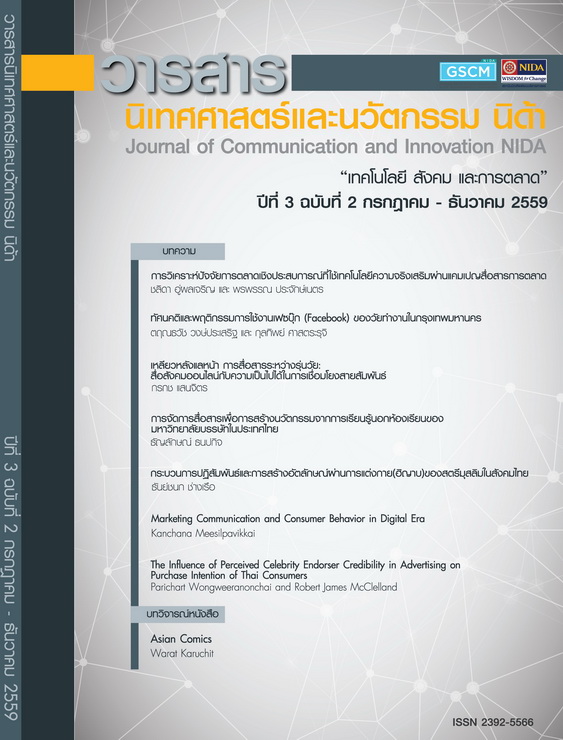เหลียวหลังแลหน้า การสื่อสารระหว่างรุ่นวัย: สื่อสังคมออนไลน์กับความเป็นไปได้ในการเชื่อมโยงสายสัมพันธ์
Main Article Content
Abstract
แนวคิดเรื่องการสื่อสารระหว่างรุ่นวัย (Intergeneration Communication) เป็นแนวคิดที่ได้รับ ความสนใจจากนักวิชาการหลายสาขามาสักระยะหนึ่งแล้ว ทว่าการปรากฏของงานวิจัยในยุคก่อนดิจิทัลนั้น ยังเป็นการเชื่อมโยงในลักษณะของการมีปฏิสัมพันธ์กันแบบเห็นหน้าค่าตา หรือการสื่อสารระหว่างบุคคลเสียมากกว่า หากแม้จะมีสื่อกลางมาเชื่อมโยงความสัมพันธ์ก็จะเป็นลักษณะของการใช้ สื่อประเพณี หรือ สื่อพื้นบ้านเช่นของเล่นเด็กเสียเป็นส่วนใหญ่
เมื่อเทคโนโลยีใหม่ๆ เข้ามาเปลี่ยนแปลงรูปแบบการดำเนินชีวิต ประกอบกับโครงสร้างของสังคมไทยที่เปลี่ยนแปลงไป การเปลี่ยนแปลงจากครอบครัวขยายสู่ครอบครัวเดี่ยว ส่งผลให้ความสัมพันธ์ระหว่างบุคคลในครอบครัวเปลี่ยนแปลงไปด้วย เกิดช่องว่างการสื่อสารระหว่างรุ่นวัยตามมา เมื่อสังคมไทยก้าวเข้าสู่ยุคดิจิทัล สื่อสังคมออนไลน์ ที่มีคุณสมบัติในการสื่อสารแบบสองทางผู้รับสารและผู้ส่งสารสามารถมีปฏิกิริยาโต้ตอบได้ทันที ทำให้ความสัมพันธ์ของผู้สูงวัยและเด็ก ผู้ใหญ่และผู้น้อยซึ่งเคยสัมพันธ์กันในแนวดิ่ง เปลี่ยนไปเป็นแนวราบและด้วยลักษณะความเป็นผู้สูงอายุและความเป็นเด็กนั้นต่างก็มีข้อดีและข้อเสียที่จะแลกเปลี่ยนและเติมเต็มซึ่งกันและกันได้ เช่น ผู้สูงอายุที่เปี่ยมไปด้วยประสบการณ์ความรู้ กับเด็กหรือเยาวชนที่มากไปด้วยศักยภาพความสามารถในการเข้าถึงและใช้สื่อในรูปแบบและวิธีการใหม่ๆ ทำให้เห็นความเป็นไปได้ในการใช้สื่อสังคมออนไลน์เพื่อเชื่อมโยงความสัมพันธ์ระหว่างรุ่นวัยที่เคยห่างหายไปให้กลับคืนมาอีกครั้งหนึ่ง
อย่างไรก็ตาม สื่อสังคมออนไลน์จะมีบทบาทสำคัญในฐานะสื่อกลางเชื่อมโยงความสัมพันธ์ระหว่างรุ่นวัยได้หรือไม่ และต้องอาศัยคุณสมบัติร่วมของแต่ละรุ่นวัยอย่างไร รวมทั้งใครจะเป็นผู้มีส่วนสำคัญในการผลักดันการเชื่อมโยงความสัมพันธ์ดังกล่าวให้เห็นเป็นรูปธรรมชัดเจนยิ่งขึ้น จึงเป็นก้าวที่น่าจับตามองต่อไป
Intergeneration Communication has been a topic of interest among several researchers and academics. However, their research has focused more on face-to-face interaction, or interpersonal communications. Even though today there are many different channels of communication, most that have been studied concerning Intergeneration Communication have examined traditional media or traditional folk media such as children's toys.
With the new technologies that are now altering people’s lifestyles and with the changing structure of Thai society, from the extended family to the single family, we are seeing changes in the relationship between the elderly and their children, adults and minors. Once a vertical relationship, these are changing to a horizontal relationship, which reduced the gap of intergeneration relationships in society. This has led to different advantages and disadvantages for the elderly and younger generation in communicating and relating to one another. For instance, the elderly, with their experience and knowledge, and young people, including their children, with their skills and potentials, are each accessing and adopting different media in new ways and formats.
In this age of communication without borders, social media affords mutual space for message senders and receivers. The question then becomes what role social media can play in intergeneration relations as well as age as a mediator. There is also the question of effect of qualifications and skills of each intergeneration communication participant who plays a role in developing the relationship.
Article Details
ข้อความและความเห็นในวารสารนิเทศศาสตร์และนวัตกรรม นิด้า เป็นของผู้เขียนแต่ละท่าน มิใช่ของคณะนิเทศศาสตร์และนวัตกรรมการจัดการ สถาบันบัณฑิตพัฒนบริหารศาสตร์


